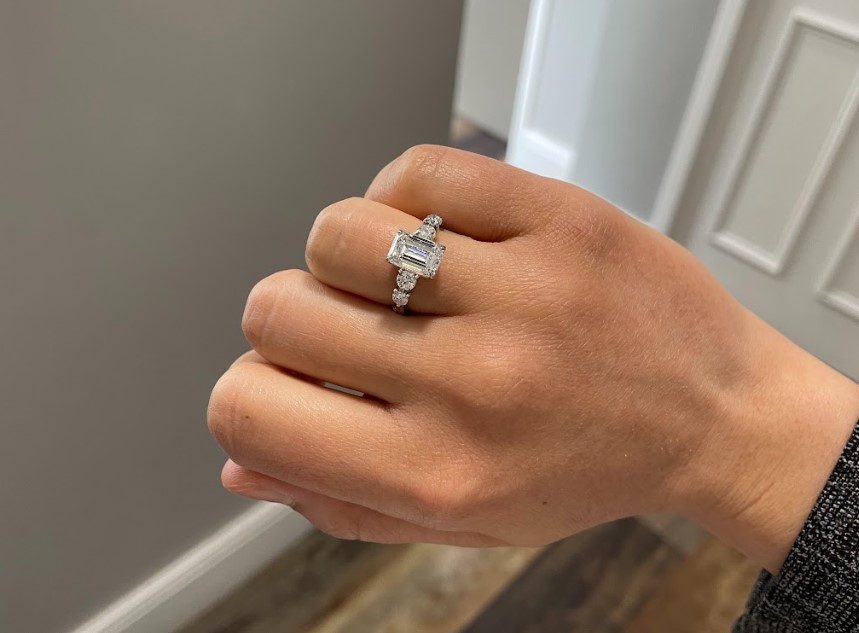
When it comes to choosing a gemstone—especially for something as special as an engagement ring—diamonds have long reigned supreme. But in recent years, moissanite has emerged as a stunning, ethical, and budget-friendly alternative. If you’re torn between the two, here’s everything you need to know about moissanite vs diamond, from sparkle to sustainability.
What Is Moissanite?
Moissanite is a lab-created gemstone that was originally discovered in a meteor crater by French chemist Henri Moissan in 1893. Natural moissanite is incredibly rare, so today’s stones are almost exclusively grown in labs using advanced technology.
Its chemical composition is silicon carbide, and while it’s not a diamond, it’s often mistaken for one due to its appearance.
What Is a Diamond?
A diamond is a naturally occurring gemstone made of carbon atoms arranged in a crystal structure. It’s the hardest known natural material and has been prized for centuries for its brilliance, durability, and symbolism of eternal love.
Diamonds can also be lab-created, which are chemically and visually identical to natural ones, but they’re produced in a more controlled, ethical environment.
Key Differences: Moissanite vs. Diamond
| Feature | Moissanite | Diamond |
|---|---|---|
| Brilliance | More fiery, rainbow-like sparkle | Classic white brilliance |
| Hardness (Mohs scale) | 9.25 | 10 |
| Durability | Extremely durable | The most durable gemstone |
| Color | Often near-colorless or slightly warm | Ranges from colorless (D) to yellow (Z) |
| Price | 70–90% less than diamonds | Expensive, especially natural diamonds |
| Origin | Lab-created | Natural or lab-created |
| Ethics/Sustainability | Always conflict-free, eco-friendly | Can be mined or lab-grown (ethical issues may vary) |
Brilliance and Sparkle
Moissanite has a higher refractive index (2.65–2.69) than diamonds (2.42), meaning it can sparkle more intensely—sometimes producing a rainbow-like effect. This can be mesmerizing or slightly “too much” for those who prefer the more classic shimmer of diamonds.
Durability for Daily Wear
Diamonds are the hardest gemstone on Earth, scoring a perfect 10 on the Mohs scale, making them virtually scratch-proof. Moissanite comes close at 9.25, meaning it’s still highly resistant to scratches and suitable for everyday wear, including engagement rings.
Cost Comparison
Moissanite is significantly more affordable than diamonds. For example, a 1-carat moissanite might cost around $300–$600, while a 1-carat diamond can range from $3,000 to $10,000+, depending on quality and origin.
Ethical and Environmental Factors
Since moissanite is always lab diamonds, it’s guaranteed to be conflict-free and more environmentally friendly. Diamonds, especially those mined in traditional ways, have long been associated with ethical concerns, though many companies now offer certified conflict-free or lab-grown diamonds.
Which One Should You Choose?
Here’s a quick guide:
- Choose moissanite if you want:
✅ Affordability
✅ Eco-friendly and ethical sourcing
✅ Lots of sparkle
✅ A high-quality alternative to diamonds - Choose diamond if you want:
✅ A classic and traditional gem
✅ Maximum durability
✅ Investment value
✅ A natural or lab-created gem with traditional prestige
Final Thoughts
Both moissanite and diamonds are beautiful, durable, and meaningful choices. Your decision ultimately comes down to personal values, budget, and aesthetic preference. Whether you’re drawn to the brilliant sparkle of moissanite or the timeless elegance of diamonds, what matters most is that the gem reflects your story and style.
